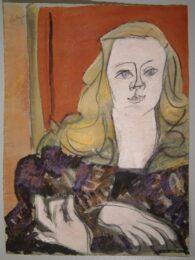

1891-1972
French painter and engraver born in Toulouse, France.
His work developed through still life and female nudes to a powerfully colored cubism. In the 1950s, the simplification of forms brought him closer to abstraction.
Latapie moved to Paris when young where he studied at the Académie Julian in 1908 and the Académie Ranson in 1909. During the 1920s he exhibited in a number of one-man shows at the famous Galerie Druet. He was associated with Georges Braque and especially with Roger Bissière with whom he held a show in New York in 1923.
A comprehensive retrospective of his works was held at the Salon d’Automne in 1936. In 1941 he exhibited with Desnoyer, Estéve, Fautrier, Lorjou, Pignon and Manessier.
Like many of his colleagues of the post-war avant-garde in Paris, having both pursued and inherited the lessons of the most daring pictoral experiments, Latapie strove successfully to re-instil the Classicist element: “Cet artiste est l’un des plus distingués d’entre ceux qui eurent pour tâche d’introduire un sens de la tradition dans l’amas des découvertes du début du siècle” (Benezit).
Louis Latapie exhibited at the major Paris Salons – including Salon d’Automne, Salons de Indépendants and the Salon des Tuileries and at a one-man and group exhibitions including ‘Art et Résistance’ at the Musée d’Art Moderne in Paris in 1946.
On his death in 1972 he was honoured with a major retrospective at the Palais De Papes in Avignon and in 1988 there was a retrospective of his work at the Musée Rapin in Villeneuve-sur-Lot and Musée des Augustine in Toulouse.
Further works can be found in Musée National d’Art Moderne, Centre Goorges Pompidou and Musée d’Art Moderne, both in Paris, Musée d’Art Moderne (Geneva) and local museums in Toulouse, Avignon and Poitiers.